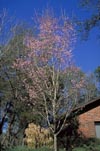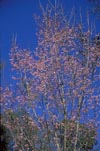Home >
Prunus x incamp 'Okame',
Okame Cherry
This tree is a hybrid between P. incisa and P. campanulata.
Provide good drainage in an acidic soil for best growth. Crowns become one-sided unless they receive light from all around the plant, so locate in full sun. Select a different plant if soil is poorly drained, but otherwise cherry adapts to clay or loam. Roots should be kept moist and should not be subjected to prolonged drought.
A regular fertilization program with slow release nitrogen is recommended to keep plants vigorous. Too much nitrogen in the soluble form could stimulate sprouting. This plant is considered mostly allergy free and causes little or no allergy problems in most people. Foliage from most members of this genus is considered poisonous when ingested. Cherries compartmentalize decay poorly meaning that decay can spread rapidly inside the tree following mechanical injury to the trunk or removing large branches.
Cherry should be grown in full sun on well-drained, acid soil to bring out the richest leaf color. It tolerates slightly alkaline soil. Tolerant of moderate heat and drought, it often succumbs to borers on poor, compacted soil. The tree transplants well but is susceptible to canker diseases which can shorten their life. Trees are sold as single trunked specimens or multi-stemmed clumps. This is one of the best flowering cherries for the deep south flowering well into the central portion of Florida.
Prune
early in the life of the tree to develop several major branches well-spaced
along a central trunk. This will improve the durability of the tree compared
to trees with many upright and spreading branches originating from one
point on the trunk. Pruning should be completed after flowering and by
late spring to ensure next year's flower buds are not removed.





